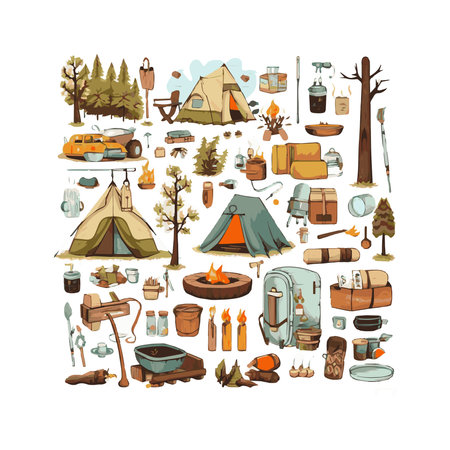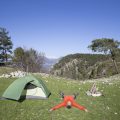1. Planning Ahead for a Seamless Adventure
Responsible camping starts long before you pitch your tent. One of the core Leave No Trace principles is to plan ahead and prepare. Thoughtful planning not only keeps you safe but also helps reduce your footprint on nature. Heres how smart preparation supports the outdoors and creates a smoother, more enjoyable trip.
Why Planning Matters
When you take time to plan properly, youre less likely to make poor decisions that can harm the environment—like setting up camp in fragile areas or getting lost and needing to create new trails. Good planning ensures you’re equipped with everything you need and ready to adapt to unexpected situations.
Key Elements of a Responsible Camping Plan
| Element | What to Consider |
|---|---|
| Route Planning | Choose established trails and campsites. Use maps or GPS tools and plan your route based on skill level and group size. |
| Weather Conditions | Check the forecast before you leave. Be prepared for sudden changes, especially in mountainous or desert areas. |
| Permits & Regulations | Research permit requirements for your destination. Some areas limit visitor numbers to protect ecosystems—apply early if needed. |
| Packing Strategies | Bring reusable items, avoid single-use plastics, pack out all trash, and carry gear appropriate for the terrain and weather. |
Smart Packing Tips Aligned With Leave No Trace
- Minimize packaging: Repack food into reusable containers at home.
- Avoid overpacking: Only bring what you truly need to reduce weight and waste.
- Leave space for trash: Bring an extra bag to carry out your garbage—and maybe even some you find along the way!
- Eco-friendly gear: Choose biodegradable soaps, solar-powered gadgets, and durable equipment that lasts.
Quick Checklist for Pre-Trip Planning
- ✔️ Research destination rules and regulations
- ✔️ Check weather forecasts daily leading up to your trip
- ✔️ Map out your route using reliable tools
- ✔️ Apply for permits if required
- ✔️ Share your itinerary with a friend or family member
- ✔️ Pack responsibly with Leave No Trace in mind
A little prep goes a long way—not just for your safety but for protecting the wild places we all love. By planning ahead, youre already taking the first step toward being a responsible camper who respects nature and helps preserve it for future generations.
2. Traveling and Camping on Durable Surfaces
When youre out exploring the great outdoors, where you walk and set up camp matters more than you might think. Staying on durable surfaces—like established trails and campsites—is key to protecting fragile environments and keeping nature wild for everyone to enjoy. Let’s break down what this principle means and how you can follow it during your camping trips.
Why Durable Surfaces Matter
Durable surfaces are areas that can handle foot traffic and camping without getting damaged. Think of them as nature’s tough spots. Walking or camping off these surfaces might not seem like a big deal at first, but over time, it can lead to soil erosion, damaged vegetation, and harm to wildlife habitats. By sticking to the right places, you help preserve natural beauty and protect delicate ecosystems.
Common Durable Surfaces
| Surface Type | Durability | Notes |
|---|---|---|
| Established Trails | High | Designed for repeated use; avoid creating new paths. |
| Designated Campsites | High | Often hardened by use; look for flat, clear areas. |
| Rock, Gravel, Sand | High | Minimal impact when walked or camped on. |
| Dry Grass or Snow | Moderate | Can recover over time but still needs care. |
| Living Soil (Moss, Lichen, Meadow) | Low | Easily damaged; avoid whenever possible. |
Selecting the Right Campsite
If youre in an area with designated sites, always use them—theyre placed with environmental protection in mind. In backcountry or dispersed camping areas, pick a spot at least 200 feet away from water sources and trails to protect riparian zones and avoid disturbing wildlife. Look for previously used sites with no living vegetation and compacted soil to minimize your impact.
Campsite Selection Tips:
- Avoid setting up camp on fragile vegetation or wet ground.
- Use existing fire rings if fires are allowed (check local regulations).
- Don’t dig trenches or build structures—leave the area as you found it.
Respect Trail Systems
Treading off-trail might be tempting when trying to find a shortcut or avoid muddy spots, but it causes long-term damage. Stick to marked trails even if they’re rocky or steep. If a trail is muddy, walk through the mud instead of around it to prevent trail widening.
Trail Etiquette Reminders:
- Avoid cutting switchbacks—it causes erosion and damages plants.
- If hiking in a group, walk single-file in the middle of the trail.
- Yield to uphill hikers and follow posted signs or closures.
By traveling and camping on durable surfaces, youre helping maintain the health of our natural areas. It’s a simple step that makes a big difference for future campers and the environment alike.
![]()
3. Proper Waste Disposal: Pack It In, Pack It Out
When youre out camping, one of the most important ways to protect nature is by managing your waste responsibly. The principle of “Pack it in, pack it out” means that whatever you bring into the wilderness, you need to take back with you — trash, leftover food, and even used toilet paper.
Disposing of Litter
Leaving behind garbage doesn’t just ruin the view; it can also harm wildlife and pollute water sources. Make sure to:
- Carry trash bags or resealable plastic bags for collecting your litter.
- Pick up all wrappers, bottle caps, and micro-trash like twist ties and food crumbs.
- Inspect your campsite before leaving for any small debris you might have missed.
Managing Human Waste
Improper disposal of human waste can contaminate water sources and spread disease. Depending on where you are camping, use these methods:
| Method | Best For | How To Do It |
|---|---|---|
| Cathole | Backcountry camping | Dig a hole 6-8 inches deep at least 200 feet from water, trails, and campsites. Cover it after use. |
| Portable toilet or wag bag | Fragile environments or desert areas | Use a carry-out system specifically designed for human waste. Dispose of it in designated facilities. |
| Vault toilet or outhouse | Developed campgrounds | Use as provided. Do not throw trash into these systems. |
Minimizing Food Waste
Food scraps might seem harmless, but they attract animals and disrupt their natural diets. Heres how to reduce food waste while camping:
- Plan meals carefully: Only pack what you’ll eat to avoid leftovers.
- Avoid overpacking: Bring reusable containers instead of single-use packaging.
- Dispose properly: Strain dishwater through a fine mesh screen and pack out food bits. Scatter strained water at least 200 feet away from any water source.
- No feeding wildlife: Even accidental feeding (like dropped snacks) can change animal behavior in harmful ways.
Wildlife Safety Tip:
Store all food and scented items in bear-proof containers or hang them according to local regulations. Never leave food unattended.
Remember:
If you brought it with you — whether its a granola wrapper or apple core — take it back with you. Leaving no trace helps keep our natural spaces wild and beautiful for everyone to enjoy.
4. Respecting Wildlife and Natural Habitats
When youre out camping, its important to remember that you’re a guest in nature’s home. The animals and plants around you live there every day, and your actions can have a big impact on their well-being. This part of Leave No Trace is all about respecting wildlife and the natural habitats they depend on.
Observe Wildlife from a Distance
Its exciting to spot a deer, bear, or bird in the wild, but keeping your distance helps keep both you and the animal safe. Use binoculars or a zoom lens if you want a closer look—never try to feed or touch wild animals. Approaching them too closely can stress them out or even cause them to abandon their nests or young.
Tips for Safe Wildlife Viewing:
| Do | Dont |
|---|---|
| Use binoculars to watch animals | Approach or chase wildlife |
| Stay quiet and move slowly | Feed animals (even snacks!) |
| Observe from trails or designated areas | Disturb nests, dens, or resting spots |
Store Food Properly
Improper food storage is one of the biggest reasons animals become aggressive or dependent on human food. Always store your food in bear-proof containers, bear hangs, or sealed bins depending on your location. Never leave snacks in your tent or unattended at your campsite.
Common Food Storage Methods:
- Bear Canisters: Hard-sided containers designed to keep bears out.
- Bear Bags & Hangs: Hanging bags high in a tree using rope systems (at least 10 feet off the ground and 4 feet away from the trunk).
- Lockable Bins: Provided at some campgrounds for safe storage.
Avoid Disrupting Ecosystems
Even small actions can harm delicate ecosystems. Stick to established trails and campsites whenever possible. Don’t pick plants, stack rocks, or build structures unless necessary for safety. Let nature stay wild so others can enjoy it too.
Simple Ways to Protect Natural Habitats:
- Camp at least 200 feet away from lakes and streams.
- Avoid walking on fragile vegetation like mosses or alpine plants.
- Don’t collect rocks, feathers, flowers, or other natural items as souvenirs.
By taking these steps, youre helping preserve the magic of the outdoors for future generations—and showing respect for the wildlife that calls it home.
5. Being Considerate of Other Visitors
Camping is about enjoying nature, but it’s also about sharing that space with others. Being considerate helps create a welcoming environment for everyone, whether you’re deep in the backcountry or at a busy national park campground. Here’s how you can be a thoughtful camper and hiker.
Noise Management
Sound carries in the outdoors, especially in quiet natural settings. Loud voices, music, and generators can disturb both wildlife and fellow campers. Keep noise levels down, especially during early mornings and late evenings. If youre using a speaker, consider switching to headphones instead.
Quiet Hours Guidelines
| Location Type | Typical Quiet Hours |
|---|---|
| National Park Campgrounds | 10 PM – 6 AM |
| Backcountry Sites | Sunset – Sunrise |
| Private Campgrounds | Varies (Check posted rules) |
Trail Etiquette
The trail is a shared space, and good manners go a long way. Yielding to others and staying aware of your surroundings helps keep everyone safe and happy.
Yielding Rules on the Trail
| You Encounter… | You Should… |
|---|---|
| Hikers going uphill | Step aside and let them pass |
| Horseback riders | Step off the trail calmly and wait until they pass |
| Bikers (if allowed) | Bikers yield to all other trail users |
Campsite Courtesy
Your campsite is your home base, but it shouldn’t feel like a party zone to others nearby. Keep your area tidy, respect boundaries, and avoid walking through other people’s campsites—even if it’s a shortcut.
Tips for a Positive Social Atmosphere
- Introduce yourself to nearby campers—it builds friendly vibes.
- Avoid setting up camp too close to others if there’s space available.
- If you bring pets, keep them under control and clean up after them.
- Follow campground rules regarding fires, alcohol use, and group size.
By being mindful of how your actions affect others, you help ensure that everyone—from solo backpackers to family groups—can enjoy the peace and beauty of the outdoors.


